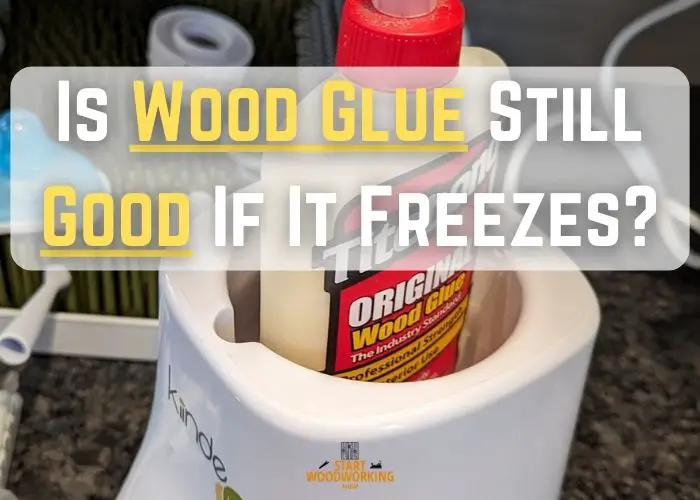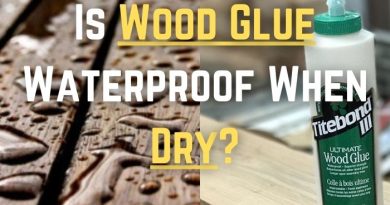Is Wood Glue Still Good If It Freezes? Find Out Now!
As someone deeply engaged in the craft of woodworking, I’ve often encountered the concern of how extreme cold temperatures might compromise the adhesive effectiveness of wood glue. Whether I’m undertaking intricate woodworking projects or simple repairs, the last thing I want is for my wood glue to fail because of something preventable like a drop in temperature.
While not ideal, wood glue that has frozen can typically still be used if it thaws smoothly. Common glues like Titebond can withstand 1-2 freeze/thaw cycles. More cycles risk the water separating out, degrading strength. Check thawed glue – if it remains smooth and creamy, it’s usually still good. But prolonged or repeated freezing poses greater risk over time.
| Glue Type | Freezing Tolerance | Minimum Use Temperature | Notes |
|---|---|---|---|
| PVA/Titebond I, II, III | Tolerant to occasional freezing | 40°F | Will re-mix after thawing with no loss of strength. Avoid repeated freeze/thaw cycles. |
| Polyurethane | Moderately tolerant | 40°F | May separate when frozen. Will re-mix but strength could degrade after multiple freezes. |
| Epoxy | Sensitive to freezing | 50°F | Epoxies will crack and lose integrity if frozen. Avoid freezing cured or uncured epoxy. |
| Hide Glue | Tolerant | 40°F | Animal-based hide glue is tolerant to freezing when dry. When wet, avoid freezing. |
| Resorcinol | Sensitive | 50°F | Freezing can cause resorcinol glues to crack and lose strength. Store above freezing. |
| Hot Melt Glue | Very sensitive | Above freezing | Hot melt glues will harden at freezing temps and lose flexibility/strength. |
| Cyanoacrylate (Super Glue) | Sensitive | 40°F | Super glues may become brittle and weaker if frozen while curing. Avoid freezing. |
| Gorilla Glue | Tolerant | 40°F | Like Titebond, Gorilla Glue can withstand occasional freezing and will re-mix after thawing. |
The Impact of Freezing on Different Types of Wood Glue
As a seasoned woodworker, I’ve noticed how the freezing impact can adversely affect various types of adhesives used in woodworking projects. With an increase in usage of water-based wood glue and PVA glues, understanding their temperature tolerance is crucial, especially in colder climates.
Freezing can affect wood glue, particularly water-based adhesives like Titebond. They can withstand a number of freeze-thaw cycles, typically up to 5, before the risk of consistency issues and reduced adhesive effectiveness arises.
Water-Based Wood Glue and Freezing Cycles
Firstly, let’s tackle the common water-based adhesives, such as PVA glues. Titebond, a leading brand in this category, acknowledges that their products, although robust, are not immune to freezing conditions.
PVA glues contain water, which forms disruptive ice crystals during freeze-thaw cycles, potentially resulting in consistency issues after the glue has been frozen and thawed multiple times.
Titebond’s glues, according to their website, are formulated to endure up to 5 such freeze-thaw cycles. However, exceeding this can lead to permanent changes in the adhesive’s properties.
| Glue Type | Freezing Impact on Consistency | Freezing Impact on Adhesive Properties |
|---|---|---|
| PVA/Titebond | Separates into a gel but remixes smoothly upon thawing | Bond strength maintained after occasional freeze. Repeated freezing may degrade strength. |
| Polyurethane | May separate into small curdled chunks but remixes. Consistency becomes thicker. | Initial strength unaffected by one freeze. Multiple freezes could degrade adhesive bond long-term. |
| Epoxy | Cracks and becomes brittle if frozen cured. Uncured epoxy will not re-emulsify after thawing. | Freezing destroys the chemical bond formation. Epoxy loses all adhesive properties and becomes ineffective. |
| Hide Glue | No change when dry. Wet hide glue separates into soft flakes but reactivates with heat. | Dried hide glue maintains strength after freezing. Wet hide glue bond is weakened significantly. |
| Resorcinol | Cracks and separates into small, hard pieces that do not fully remix. | Freezing destroys the chemical structure, preventing proper cure. Bond strength is compromised. |
| Hot Melt | Immediately hardens and becomes very brittle below freezing. | Freezing prevents the hot melt from achieving a flexible bond. Strength is negligible after freezing. |
| Cyanoacrylate | May become cloudy and brittle below freezing during cure. | Freezing interrupts polymerization process, resulting in a weak surface bond prone to failure. |
| Gorilla Glue | Similar to PVA – separates into a gel but fully remixed with no lumps. | Maintains bond integrity after an occasional freeze. Repeated freezing degrades strength over time. |
Long-Term Effects of Freezing on Wood Glue’s Bonding Strength
Repeated freeze-thaw cycles can push a wood glue’s limits, decreasing its ability to maintain a firm hold. This slow degradation means that beyond a wood glue’s recommended threshold for freeze-thaw exposure, which is often stated by manufacturers, you might find the adhesive has little to no bonding strength left.
In my experience, once the integrity of the glue is compromised, the bond you rely on for woodworking stability is at risk.
Another issue is the occurrence of glue chalking—a stark visual indicator that the glue no longer possesses the qualities needed for a reliable wood bond.
Following a freeze, if the thaw is not done promptly or properly, you may observe a white film forming on the surface where the glue was applied. This chalking signifies a breakdown in the glue’s formula, signifying a decline in its bonding potential.
- Recommended Freeze-Thaw Cycles: Adherence to manufacturer suggestions can help maintain glue efficacy.
- Visual Inspection: Look out for signs like chalking as an indicator of degradation.
- Testing Bonding Strength: Post-thaw, test the glue on scrap material to ensure it maintains its strength.
How Temperature Tolerance Varies by Glue Brand
Fascinatingly, not all glue brands exhibit the same vulnerability to cold weather. Some products have been formulated to be more resistant to the negative effects of chalking—the powdery residue that surfaces on glue as it starts to fail—than others.
Take, for instance, Titebond Aliphatic Resin. It exhibits this chalking effect at temperatures as high as 50 degrees Fahrenheit, indicating a higher susceptibility to temperature changes.
It’s clear that to ensure project success, one must select a product with temperature storage recommendations that align with the working environment’s climate.
| Brand | Glue Type | Freezing Impact Resistance (Number of Cycles) | Chalking Temperature Threshold |
|---|---|---|---|
| Titebond | PVA Glue | 5 | N/A |
| Titebond | Aliphatic Resin | N/A | 50°F |
| Gorilla | PVA Glue | 5 | 45°F |
| Elmer’s | PVA Glue | 3 | 50°F |
| Liquid Nails | Polyurethane | 2 | 40°F |
| Loctite | Epoxy | N/A | Do not freeze |
| Surehold | Hide Glue | N/A | Room temperature |
| Wolman | Resorcinol | N/A | Do not freeze |
| Bostik | Hot Melt | N/A | N/A |
| Super Glue | Cyanoacrylate | N/A | Room temperature |
Guidelines for Assessing If Wood Glue is Frozen
Here are the steps I would recommend to assess if frozen wood glue is still usable:
- Inspect the consistency of the glue. PVA/Titebond style glues should remix smoothly from a gel-like consistency with no lumps. Epoxies may be cracked or separated.
- Try stirring or mixing the glue thoroughly with a stick. PVA glues should fully incorporate back into a smooth, lump-free mixture with stirring.
- Check for any hardened or brittle pieces that do not break down when mixed. These indicate damage from freezing.
- Do a test bonding of two scrap wood pieces with the glue. Allow to fully cure.
- Try breaking the test bond apart. PVA glues should break within the wood fibers, not between the glue line, indicating full bonding.
- Compare bond strength to a control sample using fresh glue. The frozen glue bond should match fresh for PVAs to be usable.
- Consider the number of freeze-thaw cycles. More than 3 cycles may degrade longer-term strength of PVA glues.
- Avoid using frozen epoxies, cyanoacrylates or hot melts which are very sensitive to freezing damage.
- If in doubt, discard frozen glue and replace with fresh glue for critical applications. Occasional freezing is generally fine.
Reviving Frozen Wood Glue: Practical Tips and Tricks
Let’s explore some effective methods I use for thawing wood glue and restoring its original consistency for continued use.
Thawing Techniques for Wood Glue
When you’re faced with the task of thawing wood glue, patience is your best tool. I prefer to allow the glue to reach room temperature naturally, which minimizes the risk of altering its composition.
If time is of the essence, submerging the glue bottle in warm water has proven to be a reliable method.
Gentle stirring can expedite the thawing process, but it’s essential to be delicate to avoid introducing air bubbles that can compromise the glue’s strength.
Restoration Methods to Salvage the Consistency
After thawing, assessing the glue’s consistency is critical to ensure its effectiveness hasn’t diminished. In my experience, a simple test for quality is applying the adhesive to a piece of scrap wood.
If it spreads smoothly and binds well once dry, your efforts in reviving frozen glue were successful.
Occasionally, adding a minuscule amount of water—up to 5%—to water-based wood glues can aid in consistency restoration, but this is a delicate balance that should not be overdone.
- Avoid direct heat as it can degrade the glue’s properties
- Warm water baths are best for a controlled, gentle thaw
- Stir lightly after thawing to check for uniformity
- Perform a test application on scrap materials before using again
- Adding a little water may rejuvenate water-based glues
Strategies for Storing Wood Glue in Cold Seasons
As a seasoned DIY woodworker, I understand the challenges cold weather can bring, especially when it comes to preserving the quality of my wood glue.
For optimal storage, according to the manufacturers’ guidelines, a stable temperature environment is ideal. This could be as simple as a cabinet in a temperature-controlled room.
Interestingly, even household refrigeration has been suggested as a method to maintain consistency in glue temperature, though room temperature is generally preferred.
Here are some key points from wood glue manufacturers on adhesive storage and freeze resistance:
- Store wood glue in a cool, dry place to avoid extreme temperature fluctuations.
- Avoid storing glue in environments where it would be subjected to continuous freezing and thawing cycles.
- For climates that experience severe winters, internal home storage is recommended, away from the elements.
Best Practices for Preserving Glue Quality During Winter
Storing wood glue correctly when temperatures drop is critical to maintain its adhesive properties. First and foremost, keep your glue in a dark, dry space, and always at room temperature.
This helps to preserve glue quality by preventing the water inside from crystallizing, which can lead to a breakdown of its internal structure and reduce its bonding ability. Here’s a simple guide on how to store your wood glue:
| Location | Temperature | Humidity | Light |
|---|---|---|---|
| Indoor cabinet | Room temperature (68-72°F) | Low to moderate | Minimal to none |
| Basement | Consistent temperature | Controlled | No direct sunlight |
| Refrigerated space | Above freezing | Low | Darkness preferred |
Ideas for DIY Woodworkers: Keeping Glue Warm and Usable
For those of us who enjoy working on projects in cooler environments, bringing our glue indoors after a day in the workshop can be a simple yet effective strategy to prevent freezing.
An additional tip is to use a warming shelf or a climate-controlled cabinet to maintain a constant warm temperature for the glue. This not only ensures it’s ready for use but also extends its shelf life.
- Insulated storage bags for small glue bottles
- Heating pads or blankets for larger containers
- DIY warm boxes using insulated material and a heat source
Yes, it’s possible to restore the consistency of frozen wood glue. Thawing techniques include gently warming the glue on a heater, immersing the bottle in warm water, or simply allowing it to reach room temperature. For water-based glues, stirring or adding a small percentage of water may also help in restoring it.
Manufacturers of wood glue, like Titebond, offer guidelines for storage to ensure freeze resistance. They advise that their glues can generally handle a number of freeze-thaw cycles and emphasize the importance of maintaining consistent storage temperatures, preferably above the freezing point, to preserve the adhesive’s quality.
The long-term effects of freezing on wood glue can include a weakened bonding strength and risks of separation or chalking, where the glue leaves a powdery white residue. If wood glue undergoes too many freeze-thaw cycles, it may become unusable.
DIY woodworkers can keep their glue warm and usable by bringing it indoors and storing it in a stable temperature area, for instance, a heated workshop or a basement, and using warming techniques before application, ensuring it doesn’t freeze.




